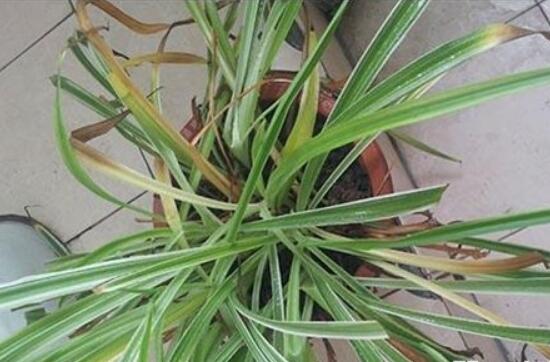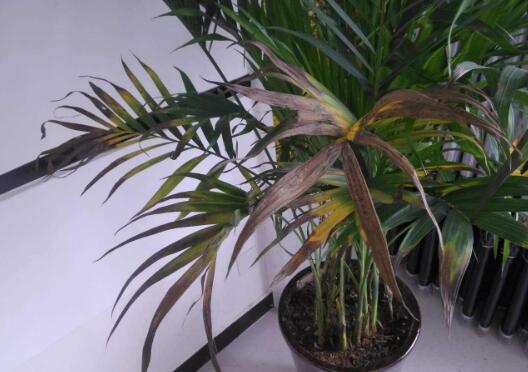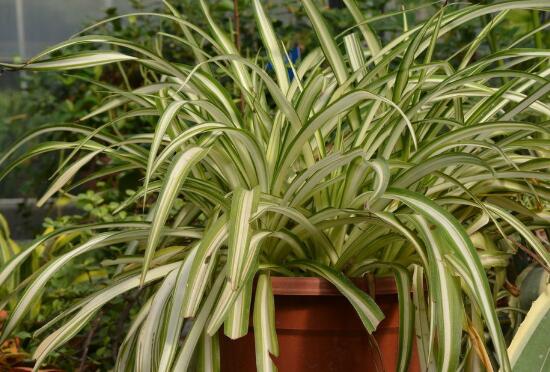What if the leaves of Magnolia are yellow? it's good to light / stop fertilizing / change the pot soil.
There are many varieties of hanging orchids, goldfish orchids, lipstick orchids and so on are very beautiful, but the most beautiful is the golden orchid, its leaves are long and light, looking very soft. In life, there are many people who nourish the golden orchid, but many people will give the leaves yellow, thus affecting the overall ornamental nature of the plant, what about the yellow leaves of the orchid? Today, the editor will solve this problem for you.
First, the leaves of Magnolia are yellow, look for the cause

As an incomparably beautiful existence in the orchid, the breeding method of the orchid is not simple, a little negligence, it will grow poorly, resulting in a variety of symptoms, such as yellow leaves, withered leaves, rotting roots and so on. As for the golden orchid leaves yellowing how to do, the editor summed up five reasons, and attached remedies, we move on.
Second, the causes and remedial measures for the yellowing and softening of the leaves of Cymbidium chinense.
1. Environmental mutation
With regard to the reason why the leaves of Magnolia are yellow, the first thing that comes to mind is the environment. Nowadays, many of the golden orchids of flower friends are purchased online, and it has high requirements for the environment, so it may change greatly in the growth environment, unable to adapt for a while, resulting in leaf yellow symptoms.
Remedy: it is very simple to ask the store about the previous growth environment, and then we change the environment at home until the orchid is fully adapted. After normal maintenance for a period of time, the leaves of the plant will recover.
2. Too much watering
The golden orchid likes the humid environment, so we need to water more to keep the basin soil moist. But the golden orchid also avoid waterlogging, once too much watering, resulting in stagnant water in the basin, the plant roots will be difficult to breathe, resulting in yellow leaves.
① soil discomfort: if the basin soil permeability, water permeability is poor, flower friends also follow the watering method of Jinxin orchid to water, it may cause stagnant water in the basin. Remedy: loosen the soil in time, or change the basin soil again.
② water too much: for beginners, the amount of water is difficult to control, coupled with the large water demand, so it is easy to water too much, the result is that the leaves of the orchid turn yellow. Remedy: move the pot to a ventilated astigmatism and let the water evaporate quickly.
3. Excessive fertilization
The growth of Magnolia can not be separated from fertilizer, the right amount of nutrients can make it grow better. Fertilizer can not be more, once more, it will burn roots, and root decay, it is easy to lead to leaves yellowing.
Remedy: stop fertilizing, irrigate more water, or turn the pot to clean the root and replace the new soil.
4. Lack of light
Although Jinxin Diaolan likes to be half overcast, it still needs to be exposed to astigmatism for at least 4 hours every day. Once the light is not enough, the chlorophyll of the leaves will decrease, and as a result, the leaves will slowly turn yellow.
Remedy: if the leaves of Magnolia lanceolata are yellow caused by lack of light, it is easy to remedy and let it receive sufficient astigmatism.
5. The basin has not been turned over for a long time.
In the initial stage of breeding, it is critical to add the right amount of fertilizer to the basin soil, so we need to change the pot every 1-2 years. Once the basin has not been turned over for a long time, the various nutrients contained in the basin soil will be consumed dry. If the three elements of nitrogen, phosphorus and potassium are not replenished in time, the plant will be yellow and thin because of the lack of nutrients.
Remedy: very simple, timely replace with fertile loam, and then apply the right amount of alum fertilizer water.
Generally speaking, although the golden orchid is not easy to raise, but be more careful, it will not have a problem. But because many flower friends are novices, it is inevitable that there will be symptoms of leaf yellow. However, after reading the full text, I believe you have a clear mind, the leaf yellow problem can be remedied in accordance with the above method. With regard to the yellow and soft leaves of Magnolia, this is the editor's introduction, hoping to give you some help.
How to do the leaf withering of Magnolia lanceolata? suitable light / proper watering / reasonable fertilization
As the most outstanding existence in the orchid, the efficacy of the orchid is very powerful, but the most impressive is its beautiful leaves, like a green waterfall, pouring down, just like a fairy coming down to earth, very beautiful. So when the golden orchid leaves withered, the flower friends must be very anxious! In order to solve this problem, the editor summed up four reasons, let's have a look.
First, the leaves of Magnolia lanceolata withered, find the reason.
As a common potted plant, the breeding method of Magnolia is not simple, and a little negligence, it will have a variety of problems, such as yellow leaves, leaf withering and so on, seriously affecting the ornamental of the plant. As for the golden orchid leaf withered how to do? Generally speaking, it is reflected in light, watering, fertilization and humidity, and we move on to the details.
2. The causes and solutions of leaf withering of Cymbidium chinense.
1. Improper lighting
① lack of light: Magnolia likes semi-overcast environment, can not be light in the process of growth. Once it is in a dark environment for a long time, the orchid will not get enough nutrients because of insufficient photosynthesis, causing the leaves to wither. Solution: very simple, add light, but the light can not be too strong, astigmatism can.
② light is too strong: Golden orchid bogey bright light, once placed in the sun in summer, its leaves will be withered by exposure. Solution: move to astigmatism (the best shading rate is about 50%), slow down and then water properly, and the leaves will return to health after a period of time.
2. Improper watering
① insufficient watering: the growth of Magnolia can not be separated from water, once the watering is too little, the leaves can not absorb enough water for a long time, it will slowly wither. Solution: very simple, replenish water, but not too much, just keep the basin soil moist.
② overwatering: although the orchid likes the wet environment, but too much watering, resulting in the basin soil is too wet, it will cause the emergence of rotting roots, its external performance may be leaf withering. Solution: stop watering, cut off the roots after taking off the basin, and change the pot soil to plant again.
3. Improper fertilization
① insufficient fertilization: the growth of Magnolia needs sufficient nutrients, once too little fertilization, resulting in insufficient nutrients, its leaves will be undernourished and withered. Solution: very simple, appropriate amount of fertilizer can be applied, compound fertilizer can be applied every 20 days during the growing period, the main fertilizer should not be splashed on the leaves.
② excessive fertilization: in the growth process of Magnolia, sufficient fertilizer can make the leaves greener and more beautiful, but once excessive fertilization, it will cause root burning, the result is that the leaves can not absorb water and nutrients and wither. Solution: pour water to dilute the fertilizer, remove the pot and cut off the roots in severe cases, and then replant.
4. Improper humidity
In addition to the above points, the leaf withering of Magnolia may also be caused by humidity. It is understood that the orchid is very sensitive to air humidity. Once the indoor humidity is relatively large or small, it will affect plant growth and lead to leaf wilting.
Solution: in summer and autumn, when the indoor air is relatively dry, wet water should be sprayed on and around the leaves of the plant in order to increase the humidity of the air and make the plant grow vigorously.
How to get black in the middle of the leaves? learn 5 tricks to solve it easily / pay attention to water and fertilizer
Golden orchid, the best in the orchid, it is a good-looking, green, but also formaldehyde-absorbing plant, raised at home by many flower friends. But in the process of breeding, many flower friends will encounter various problems, such as yellowing, blackening, withering and so on, affecting the ornamental nature of the plant. So, what if the leaves of Magnolia are black in the middle? Today, the editor is here to solve this problem for everyone.
First, the leaves of Magnolia are blackened in the middle, looking for the cause.
As the best variety in the orchid, the orchid is very beautiful, but at the same time it is also difficult to raise! Coupled with many novices, so raising, many flower friends of the golden heart orchid will appear the symptoms of blackening leaves. At that time, the flower friends must be in a hurry! As for the golden orchid leaves blackened in the middle how to do, in fact, it is very simple, learn the following 5 tricks can be easily solved, we continue to look down.
Second, the causes and solutions of blackening in the middle of the leaves of Cymbidium chinensis.
1. Soil problems
To say that the leaves of Magnolia are black in the middle, in fact, there are many reasons. If we think that there is no problem with conservation, then we should consider whether there is something wrong with the soil. Because the orchid is in the growing period, if the soil is breathable and permeable and cannot be drained in time, it is easy to cause rotten roots, resulting in symptoms of blackening of leaves.
Solution: if it is a soil problem, it is also simple to solve, directly replace the goldfish orchid with soil with rich and loose soil and good air permeability.
2. Lighting problem
Magnolia can not do without light, once the lack of light, it is not conducive to growth, the result may lead to blackening in the middle of the leaves; in addition, Magnolia taboo strong light direct light, once exposed in the summer sun, its leaves may also be blackened.
Solution: give the orchid sufficient light, but need shade in the strong light. So the best thing to do is to put the orchid in a semi-cool place, keep the light adequate but not strong, and the leaves will return to health after a period of time.
3. Improper watering
Water is the key to the healthy growth of Cymbidium, once too much or too little watering will cause poor plant growth, and the final result may lead to blackening in the middle of the leaves.
Solution: to water the orchid, to control the scale, it is best to follow the watering method of the orchid.
4. Insufficient humidity
Magnolia has a high requirement for humidity. If the air is too dry, its leaves will also have problems, and blackening is just one of the symptoms.
Solution: when the air is dry, spray water to the orchid to keep the basin soil and the surrounding air moist.
5. Improper fertilization
After watering, let's talk about fertilization, it is also one of the reasons why the leaves of Magnolia are blackened. If you fertilize the orchid too much or too little, it is not conducive to the growth of the orchid, and the final adverse consequences will be shown on the leaves.
Solution: apply proper amount of fertilizer to Cymbidium, and compound fertilizer can be applied once in about 20 days during the growing period. Besides, be careful not to splash fertilizer on the leaves when you are fat.
- Prev

What if the rich coconut leaves turn yellow, apply thin fertilizer / replenish water / shade / prevent diseases and insect pests
Rich coconut is a kind of foliage plant native to New South Wales, Australia, and later introduced to China. Nowadays, it can be seen in many parts of our country. However, if the leaves of high ornamental plants turn yellow, it will also affect their overall beauty, so what about the rich coconut leaves that turn yellow?
- Next

How to do the rotten roots of Cymbidium, reasonable water and fertilizer / cut off the rotten roots / change the potted soil and replant
Golden orchid, the most beautiful one, it is slender and drooping, with yellow and white vertical stripes in the middle, very beautiful and generous. But once the roots of Cymbidium are rotten, there will be a variety of problems in its leaves, thus affecting the overall ornamental of the plant. So, what about the rotten roots of the golden orchid? To this
Related
- Fuxing push coffee new agricultural production and marketing class: lack of small-scale processing plants
- Jujube rice field leisure farm deep ploughing Yilan for five years to create a space for organic food and play
- Nongyu Farm-A trial of organic papaya for brave women with advanced technology
- Four points for attention in the prevention and control of diseases and insect pests of edible fungi
- How to add nutrient solution to Edible Fungi
- Is there any good way to control edible fungus mites?
- Open Inoculation Technology of Edible Fungi
- Is there any clever way to use fertilizer for edible fungus in winter?
- What agents are used to kill the pathogens of edible fungi in the mushroom shed?
- Rapid drying of Edible Fungi

